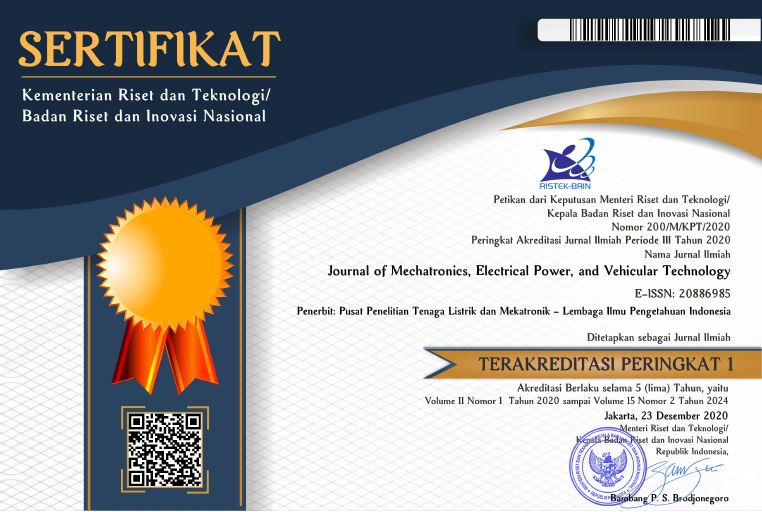Design and kinematic analysis of a two-DOF moving platform as a base for a car simulator
Abstract
Keywords
Full Text:
PDFReferences
K. A. Brookhuis, “Driving simulator,” in International Encyclopedia of Transportation, Elsevier, Amsterdam, The Netherlands, pp. 14-19, 2021.
O. X. Kuiper, J. E. Bos, C. Diels, and K. Cammaerts, “Moving base driving simulators’ potential for carsickness research,” Applied Ergonomics, 81, 102889, pp. 1-5, 2019.
Y. Maruyama and S. Sakaki, “Development of driving simulator for the experiment of tsunami evacuation using automobile,” in Proc. of the 7th International Conference on Asian and Pacific Coasts (APAC), pp. 454-459, 2013.
A. E. Gomez, T. C. dos Santos, C. M. Massera; A. M. Neto, and D. F. Wolf, “Driving simulator platform for development and evaluation of safety and emergency systems,” Computer Science: Computers and Society, Cornell University, 2018.
A. Berthoz, W. Bles, H. Bülthoff, B. C. Grácio, P. Feenstra, N. Filliard, R. Huhne, A. Kemeny, M. Mayrhofer, M. Mulder, H. Nusseck, P. Pretto, G. Reymond, R. Schlusselberger, J. Schwandtner, H. Teufel, B. Vailleau, M. M. Van Paassen, M. Vidal, and M. Wentink, “Motion scaling for high-performance driving simulators,” in IEEE Transactions on Human-Machine Systems, 43 (3), pp. 265–276, 2013.
S. Khan and R. Chang, “Anatomy of the vestibular system: a review,” in Neuro Rehabilitation, vol. 05, no. 32, pp. 437–443, 2013.
P. Hansson, A. Stenbeck, A. Kusachov, F. Bruzelius, and B. Augusto, “Prepositioning of driving simulator motion systems,” Int. J. Vehicle Systems Modelling and Testing, vol. 10, no. 3, pp. 288–304, 2015.
L. V. Bringoux, L. Marin, P. A. Barraud, and C. Raphel, “Contribution of somesthetic information to the perception of body orientation in the pitch dimension,” in The Quarterly Journal of Experimental Psychology Section A, vol. 56, no. 5, pp. 909–923, 2003.
A. Stratulat, V. Roussarie, J. L. Vercher, and C. Bourdin, “Improving the realism in motion-based driving simulators by adapting tilt-translation technique to human perception,” in IEEE Virtual Reality, pp. 47-50, 2011.
E. Groen and W. Bles, “How to use body tilt for the simulation of linear self-motion,” Journal of Vestibular Research, vol. 14, no. 5, pp. 375–385, 2004.
N. C. Ruiz-Hidalgo, A. Blanco-Ortega, A. Abúndez-Pliego, J. Colín-Ocampo, and M. Arias-Montiel, “Design and control of a novel 3-DOF parallel robot,” in Proc. International Conference on Mechatronics, Electronics and Automotive Engineering, pp. 66-71, 2016.
X. Hu, F. Li, and G. Tang, “Kinematics analysis of 3UPU_UP coupling parallel platform in the marine environment,” IEEE Access, vol. 8, pp. 158142-158151, 2020.
A. Adel, M. Mahmoud, N. Sayed, O. Hisham, O. Ossama, P. Adel, Y. Ayman, M. I. Awad, Shady A. Maged, S. M. Umer, H. Iqbal, and H. F. Maqbool, “Design of A 6-DOF hydraulic vehicle driving simulator,” in Proc. Int. Conf. on Innovative Trends in Communication and Computer Engineering, Egypt, pp. 170-175, 2020.
H. Arioui, S. Hima, L. Nehaoua, R. J. V. Bertin, and S. Espié, “From design to experiments of a 2-DOF vehicle driving simulator,” IEEE Transactions on Vehicular Technology, 60 (2, pp. 357-368), 2011.
M. V. K. Reddy, “Orientability of the moving platform in planar cable robots,” Master Thesis, Mechanical Engineering, Indian Institute of Science, Bengaluru – 560012, India, 2019.
J. Tiana-Alsina, M. A. Gutierrez, I. Wurth, J. Puigdefabregas, and F. Rocadenbosch, “Motion compensation study for a floating Doppler wind LiDAR,” in Proc. IEEE International Geoscience and Remote Sensing Symposium (IGARSS), pp. 5370-5382, 2015.
N. Ahmad, M. K. A. Kholdun, H. Zulkefle, M. F. Abdullah, D. Kamaruzzaman, and N. E. Abdullah, “2 degree of freedom (DOF) motor control for motion simulation,” in Proc. IEEE 12th Control and System Graduate Research Colloquium (ICSGRC 2021), pp. 259-264, 2021.
M. N. A. Bin Mohd Nadiman, “Design and development of 2-DOF motion simulator for paramotor trike,” Master Thesis, Faculty of Engineering, University of Malaya, 2020.
H. M. Saputra, Z. Abidin, and E. Rijanto, “IMU application in measurement of vehicle position and orientation for controlling a pan-tilt mechanism,” Journal of Mechatronics, Electrical Power, and Vehicular Technology (MEV), 04, (1), pp. 41-50, 2013.
A. A. Rafiq, W. N. Rohman, and S. D. Riyanto, “Development of a simple and low-cost smartphone gimbal with MPU-6050 sensor,” Journal of Robotics and Control (JRC), 1(4), pp. 136-140, 2020.
Y. Zhang, K. Song, J. Yi, P. Huang, Z. Duan, and Q. Zhao, “Absolute attitude estimation of rigid body on moving platform using only two gyroscopes and relative measurements,” IEEE/ASME Transactions on Mechatronics, 23, (3), pp. 1350–1361, 2018.
A. F. Albaghdadi and A. A. Ali, “An optimized complementary filter for an inertial measurement unit contain MPU6050 sensor,” Iraqi Journal for Electrical and Electronic Engineering, 15, (2), pp. 71-77, 2019.
A. Jefiza, E. Pramunanto, H. Boedinoegroho, and M. H. Purnomo, “Fall detection based on accelerometer and gyroscope using back propagation,” in Proc. EECSI 2017, pp. 19-21.
Z. T. Al-Dahan, N. K. Bachache, and L. N. Bachache, “Design and implementation of fall detection system using MPU6050 Arduino,” Springer International Publishing Switzerland, pp. 180–187, 2016.
I. Rifajar and A. Fadlil, “The path direction control system for lanange jagad dance robot using the MPU6050 gyroscope sensor,” International Journal of Robotics and Control, pp. 27-40, 2021.
Article Metrics
Metrics powered by PLOS ALM
Refbacks
- There are currently no refbacks.
Copyright (c) 2022 Journal of Mechatronics, Electrical Power, and Vehicular Technology

This work is licensed under a Creative Commons Attribution-NonCommercial-ShareAlike 4.0 International License.





















